Dichloramine B
Modify Date: 2024-01-20 12:40:39
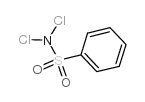
Dichloramine B structure
|
Common Name | Dichloramine B | ||
|---|---|---|---|---|
| CAS Number | 473-29-0 | Molecular Weight | 226.08000 | |
| Density | 1.562g/cm3 | Boiling Point | 319.2ºC at 760mmHg | |
| Molecular Formula | C6H5Cl2NO2S | Melting Point | 74ºC | |
| MSDS | N/A | Flash Point | 146.8ºC | |
| Name | N,N-dichlorobenzenesulfonamide |
|---|---|
| Synonym | More Synonyms |
| Density | 1.562g/cm3 |
|---|---|
| Boiling Point | 319.2ºC at 760mmHg |
| Melting Point | 74ºC |
| Molecular Formula | C6H5Cl2NO2S |
| Molecular Weight | 226.08000 |
| Flash Point | 146.8ºC |
| Exact Mass | 224.94200 |
| PSA | 45.76000 |
| LogP | 3.06570 |
| Vapour Pressure | 0.000344mmHg at 25°C |
| Index of Refraction | 1.594 |
|
Dichloramine B
SAFETY DATA SHEET Section1. IDENTIFICATION Product name:Dichloramine B Section2. HAZARDS IDENTIFICATION GHS classification
PHYSICAL HAZARDS
Category 1 Oxidizing solids HEALTH HAZARDS Category 2 Skin corrosion/irritation Serious eye damage/eye irritationCategory 2A Not classified ENVIRONMENTAL HAZARDS GHS label elements, including precautionary statements Pictograms or hazard symbols Signal wordDanger Hazard statementsMay cause fire or explosion; strong oxidizer Causes skin irritation Causes serious eye irritation Precautionary statements: Keep away from heat. [Prevention] Keep away from clothing and other combustible materials. Take any precaution to avoid mixing with incompatible materials such as combustibles. Wash hands thoroughly after handling. Wear protective gloves/eye protection/face protection. Wear fire/flame resistant/retardant clothing. [Response]IF IN EYES: Rinse cautiously with water for several minutes. Remove contact lenses, if present and easy to do. Continue rinsing. If eye irritation persists: Get medical advice/attention. IF ON SKIN: Gently wash with plenty of soap and water. If skin irritation occurs: Get medical advice/attention. IF ON CLOTHING: Rinse immediately contaminated clothing and skin with plenty of water before removing clothes. Take off contaminated clothing and wash before reuse. In case of major fire and large quantities: Evacuate area. Fight fire remotely due to the risk of explosion. [Disposal]Dispose of contents/container through a waste management company authorized by the local government. Dichloramine B Section3. COMPOSITION/INFORMATION ON INGREDIENTS Substance/mixture:Substance Components:Dichloramine B Percent:>95.0%(T) CAS Number:473-29-0 Synonyms:Benzenesulfonedichloramide Chemical Formula:C6H5Cl2NO2S Section4. FIRST AID MEASURES Inhalation:Remove victim to fresh air and keep at rest in a position comfortable for breathing. Get medical advice/attention if you feel unwell. Skin contact:Rinse immediately contaminated clothing and skin with plenty of water before removing clothes. Immediately call a POISON CENTER or doctor/physician. Eye contact:Rinse cautiously with water for several minutes. Remove contact lenses, if present and easy to do. Continue rinsing. If eye irritation persists: Get medical advice/attention. Ingestion:Get medical advice/attention if you feel unwell. Rinse mouth. A rescuer should wear personal protective equipment, such as rubber gloves and air- Protection of first-aiders: tight goggles. Section5. FIRE-FIGHTING MEASURES Suitable extinguishingDry chemical, foam, water spray, carbon dioxide. media: Specific hazards arising Explosion risk in case of fire. Fight fire remotely due to the risk of explosion. from the chemical:Take care as it may decompose upon combustion or in high temperatures to generate poisonous fume. Precautions for firefighters: Fire-extinguishing work is done from the windward and the suitable fire-extinguishing method according to the surrounding situation is used. Uninvolved persons should evacuate to a safe place. In case of fire in the surroundings: Keep containers cool by spraying with water. Eliminate all ignition sources if safe to do so. Special protectiveWhen extinguishing fire, be sure to wear personal protective equipment. equipment for firefighters: Section6. ACCIDENTAL RELEASE MEASURES Use personal protective equipment. Keep people away from and upwind of spill/leak. Personal precautions, protective equipment and Entry to non-involved personnel should be controlled around the leakage area by emergency procedures: roping off, etc. Environmental precautions: Prevent product from entering drains. Methods and materials for Sweep dust to collect it into an airtight container, taking care not to disperse it. containment and cleaning Adhered or collected material should be promptly disposed of, in accordance with up: appropriate laws and regulations. Prevention of secondary Remove all sources of ignition. Fire-extinguishing devices should be prepared in hazards:case of a fire. Use spark-proof tools and explosion-proof equipment. Since there is a possibility of igniting behind when removal of a leakage thing is imperfect, it is careful enough. Section7. HANDLING AND STORAGE Precautions for safe handling Technical measures:Handling is performed in a well ventilated place. Wear suitable protective equipment. Be careful not to cause leakage, overflow, or dispersion. Steam should not be generated unnecessarily. Keep away from heat/sparks/open flame/hot surfaces. -No smoking. Take measures to prevent the build up of electrostatic charge. Use explosion-proof equipment. Avoid shock and friction. Wash hands and face before breaks and immediately after handling the product. Use a local exhaust if dust or aerosol will be generated. Avoid contact with skin, eyes and clothing. Advice on safe handling: Dichloramine B Section7. HANDLING AND STORAGE Don't leave used equipment or rag. This product may ignite if it is left stuck on combustibles such as paper, rags, etc. Conditions for safe storage, including any incompatibilities Storage conditions:Keep container tightly closed. Store in a cool and dark place. Store under inert gas. Be sure not to give the container unexpected impacts, such as falling down or falling off. Store away from combustibles. Air-sensitive Packaging material:Comply with laws. Section8. EXPOSURE CONTROLS / PERSONAL PROTECTION Engineering controls:Install a closed system or local exhaust as possible so that workers should not be exposed directly. Also install safety shower and eye bath. Personal protective equipment Respiratory protection: Dust respirator. Follow local and national regulations. Hand protection:Protective gloves. Safety glasses. A face-shield, if the situation requires. Eye protection: Skin and body protection: Fire/flame resistant/retardant protective clothing. Protective boots, if the situation requires. Section9. PHYSICAL AND CHEMICAL PROPERTIES Physical state (20°C):Solid Form:Crystal- Powder White - Slightly pale yellow green Colour: Odour:No data available pH: No data available Melting point/freezing point:74°C No data available Boiling point/range: Flash point:No data available Flammability or explosive limits: No data available Lower: Upper:No data available Relative density:No data available Solubility(ies): No data available [Water] [Other solvents] Methanol, Chloroform Soluble: Section10. STABILITY AND REACTIVITY Chemical stability:Stable under proper conditions. Possibility of hazardous May explosively decompose on heating, shock, friction, etc. reactions:May cause fire or explosion on contact with reducing agents or mixing with combustibles. Conditions to avoid:Heat, Shock, Friction, Light Incompatible materials: Oxidizing agents, Reducing agents, Strong acids, Combustibles, Organic substances Hazardous decomposition Carbon monoxide, Carbon dioxide, Nitrogen oxides (NOx), Sulfur oxides, Hydrogen products:chloride Section11. TOXICOLOGICAL INFORMATION No data available Acute Toxicity: Skin corrosion/irritation: No data available Serious eyeNo data available damage/irritation: Germ cell mutagenicity: No data available Dichloramine B Section11. TOXICOLOGICAL INFORMATION Carcinogenicity: No data available IARC = NTP =No data available No data available Reproductive toxicity: Section12. ECOLOGICAL INFORMATION Ecotoxicity: Fish:No data available Crustacea:No data available Algae:No data available Persistence / degradability: No data available BioaccumulativeNo data available potential(BCF): Mobility in soil Log Pow:No data available Soil adsorption (Koc):No data available Henry's LawNo data available constant(PaM3/mol): Section13. DISPOSAL CONSIDERATIONS Recycle to process, if possible. Consult your local regional authorities and an expert of disposal. If it mixes with inflammable solvents, it may catch fire. Observe all federal, state and local regulations when disposing of the substance. Section14. TRANSPORT INFORMATION Hazards Class:5.1: Oxidizer. UN-No:1479 Proper shipping name:Oxidizing solid, n.o.s. Packing group:I Section15. REGULATORY INFORMATION Safe management ordinance of dangerous chemical product (State Council announces on January 26, 2002 and revised on February 16,2011): Safe use and production, the storage of a dangerous chemical, transport, loading and unloading were prescribed. SECTION 16 - ADDITIONAL INFORMATION N/A |
| Hazard Codes | Xi |
|---|---|
| Risk Phrases | 8-36/37/38 |
| Safety Phrases | 17-26-36/37/39 |
| RIDADR | UN 1479 |
| HS Code | 2935009090 |
|
~95% 
Dichloramine B CAS#:473-29-0 |
| Literature: Sanapo, Gabriel F.; Daoust, Benoit Tetrahedron Letters, 2008 , vol. 49, # 26 p. 4196 - 4199 |
|
~% 
Dichloramine B CAS#:473-29-0 |
| Literature: Derkach,N.Ya. et al. Journal of Organic Chemistry USSR (English Translation), 1979 , vol. 15, p. 1381 - 1384 Zhurnal Organicheskoi Khimii, 1979 , vol. 15, p. 1547 - 1551 |
|
~% 
Dichloramine B CAS#:473-29-0 |
| Literature: Derkach,N.Ya. et al. Zhurnal Organicheskoi Khimii, 1974 , vol. 10, # 9 p. 1873 - 1877,1884 - 1888 |
|
~% 
Dichloramine B CAS#:473-29-0 |
| Literature: Raju; Mohana; Yathirajan; Rangappa Indian Journal of Chemistry - Section A Inorganic, Physical, Theoretical and Analytical Chemistry, 2001 , vol. 40, # 6 p. 613 - 615 |
|
~% 
Dichloramine B CAS#:473-29-0 |
| Literature: Chattaway Journal of the Chemical Society, 1905 , vol. 87, p. 159 |
|
~% 
Dichloramine B CAS#:473-29-0 |
| Literature: Chattaway Journal of the Chemical Society, 1905 , vol. 87, p. 159 |
| Precursor 6 | |
|---|---|
| DownStream 10 | |
| HS Code | 2935009090 |
|---|---|
| Summary | 2935009090 other sulphonamides VAT:17.0% Tax rebate rate:9.0% Supervision conditions:none MFN tariff:6.5% General tariff:35.0% |
| N,N-dichlorobenzenesulphonamide |
| Benzenesulfonamide,N,N-dichloro |
| AC1Q6V9S |
| N,N-Dichlorobenzenesulfonamide |
| halogen h1 |
| AC1L28XT |
| Benzenesulfonedichloramide |
| N,N-dichloro-benzenesulfonamide |
| N,N-dichloroamide of benzenesulfonic acid |
| N,N-Dichloroethylbenzenesulfonamide |
| N-dichlorobenzenesulfonamide |
| EINECS 207-461-9 |
| Dichloramine B |
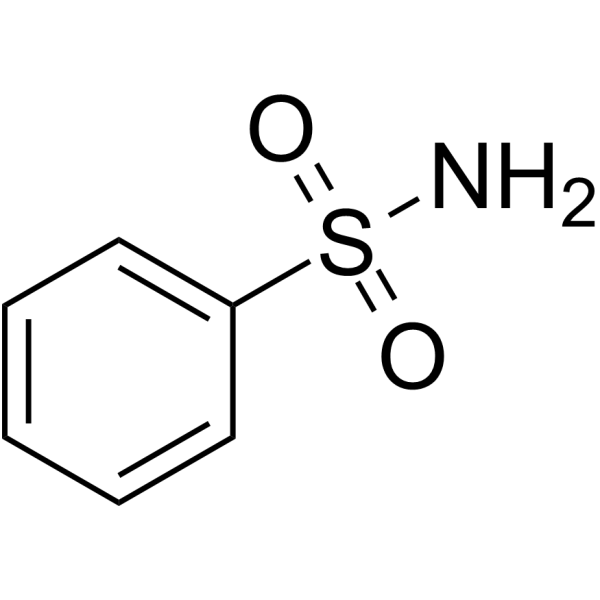
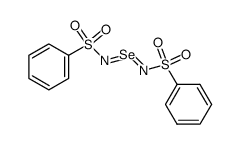
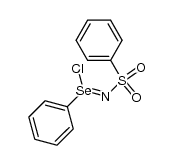
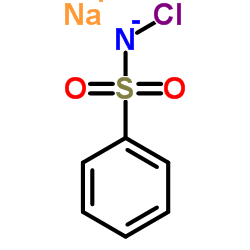


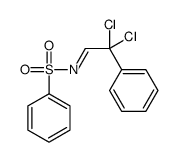 CAS#:147116-69-6
CAS#:147116-69-6 CAS#:42149-74-6
CAS#:42149-74-6![N-[N-(benzenesulfonyl)-S-phenylsulfinimidoyl]benzenesulfonamide structure](https://www.chemsrc.com/caspic/261/18112-86-2.png) CAS#:18112-86-2
CAS#:18112-86-2 CAS#:814-49-3
CAS#:814-49-3![N-[(Diethylamino)methylene]benzenesulfonamide structure](https://www.chemsrc.com/caspic/069/29665-24-5.png) CAS#:29665-24-5
CAS#:29665-24-5 CAS#:2948-79-0
CAS#:2948-79-0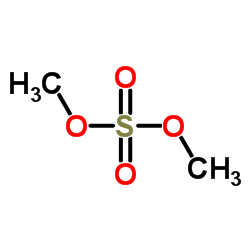 CAS#:77-78-1
CAS#:77-78-1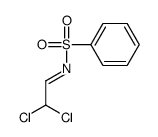 CAS#:113791-97-2
CAS#:113791-97-2![N-{2,2-dichloro-1-[(phenylsulfonyl)amino]ethyl}benzenesulfonamide structure](https://www.chemsrc.com/caspic/305/79054-58-3.png) CAS#:79054-58-3
CAS#:79054-58-3